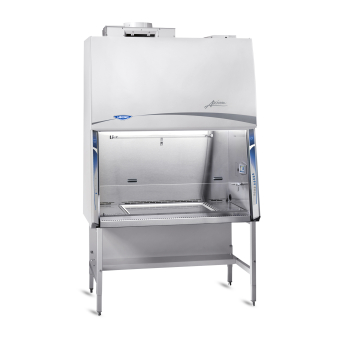Application Note: Safe Chemical Handling in the Purifier Axiom
Abstract:

A new Type of Class II BSC has emerged that will simplify the selection process and provide true flexibility in modern laboratories needing both chemical and biological protection. Along with 3rd party validation in biological challenges by NSF International®, the Purifier Axiom Class II BSC was put under ASHRAE 110 containment testing for chemical hazards to verify its ability to handle chemical hazards as well as a fume hood.
Introduction:
Confusion exists amongst lab managers and researchers regarding the proper selection and installation of Class II Biological Safety Cabinet (BSC) types. The difference between the types of Class II BSCs are their inherent ability to contain hazardous chemical vapors that are produced during microbiological or other hazardous particulate handling.
In that vein, the Purifier Axiom rivals the chemical protection of the existing Class II, Type B BSCs during operation and exceeds personnel and lab protection during failure.
Experimental Conditions:
Using a modified ASHRAE 110 fume hood methodology, the Purifier Axiom was tested for chemical containment using Sulfur Hexafluoride (SF6) tracer gas. This method includes three tests: (1) flow visualization, (2) face velocity measurement, and (3) tracer gas containment.
The tracer gas containment test was performed on the Axiom in an ideal lab setting and installation and again with an NIH-specified cross draft, simulating real world foot traffic.
Results:
Following several batteries of testing for biological containment using smoke, mist and aerosol generators, the flow visualization test using theatrical smoke generators showed a high degree of containment and directional airflow, characteristic of a Class II Biosafety Cabinet.
Face velocity measurement and characterization showed an average in line with nominal at 105 feet per minute (fpm) (max 107 fpm, min 102 fpm). NSF/ANSI Standard 49 (NSF 49) requires Class II Type A2 and Type B cabinets to maintain face velocities above 100 fpm; typically the range is 100 – 110 fpm.
The tracer gas containment testing found that no breach of SF6 was detected at the face of the cabinet, at the exhaust inlet relief valve, or in the room.
Conclusions:
When tested to the long-held standard of chemical safety for fume hoods, the Purifier Axiom Class II BSC, in operation, exhibits the highest level of containment measureable; rivaling the protection provided by existing Class II, Type B BSCs.
Furthermore, Type B BSCs are required by NSF 49 to interlock their internal fans with remote exhaust. In a best case scenario, under remote exhaust failure, then, a Type B BSC’s internal fan must shut off and turn the enclosure into a so-called dead-air box, offering no protection. Exclusive programming of the Purifier Axiom allows the cabinet to maintain safe airflow for a programmable (up to 5 minutes) duration of time during a detected remote exhaust failure; this is called the Active Protection Protocol. This program makes the Purifier Axiom the safest chemical-handling BSC available in both operation and under remote exhaust failure conditions.
Download this Application Note here:
References
American Socieity of Heating, Refrigerating and Air-Conditioning Engineers, Inc. (1995). ASHRAE 110 Method of Testing Performance of Laboratory Fume Hoods. Atlanta, Georgia, USA.
NSF International. (2012). NSF/ANSI 49 Biosafety Cabinetry: Design, Construction, Performance and Field Certification. Ann Arbor, Michigan, USA.
| chevron_left | Video: Protector XStream designed for containment | Articles | How to select the correct Cold Trap | chevron_right |





